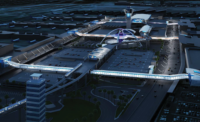The federal transportation trust fund remains moored as competing interests in Congress wrangle over spending priorities. Meanwhile, transportation agencies, anticipating a resurgence in cargo as the Panama Canal is expanded and as the economy improves, are moving forward with united interests, despite uncertainties over funding.
Four years ago, the U.S. Dept. of Transportation granted $15 million to Arizona, California, Nevada and Utah to begin studying some 840 miles of Interstate 15 for optimal freight movement, part of its Corridors of the Future program, which is now in limbo as it awaits further funding. But Susan Martinovich, director of the Nevada Dept. of Transportation, saw no reason to stop planning for the future.
“The reality is that there are no identified funding sources now,” she says. “But when there is, we will come in as a coalition. The products of this effort will be short range to long range.”
The four states have expanded that effort to include some 50 public and private agencies, including railroads, ports and cities. “Everyone jumped in with both feet,” says Sondra Rosenberg, NDOT project manager.
Last month the I-15 Mobility Alliance identified 27 high-priority projects ranging from $100 million to $500 million, says Bardia Nezhati, project manager with CH2M Hill, which is developing the I-15 master plan. They range from highway, bridge and toll road projects to port connectors, transit projects and traffic management and feasibility studies.
“This list can be done within the next five years,” says Rosenberg. “At the same time we’re working on future decades of regional-level projects.” The ultimate result will be a database of documents that future decision-makers can use to keep the master plan going, adds Nezhati.
The common goal is to emphasize projects that facilitate freight movement on I-15. Long term, the alliance envisions a corridor that will also facilitate the transport of utility output and fiber optic communications.
Two of the 27 high-priority projects would improve access inland from the Port of San Diego. “We’re not sure how the information will be used by the U.S. DOT, but these kinds of efforts can be used to help it prioritize,” says Muggs Stoll, director of transportation for the San Diego Association of Governments, an alliance member.
Corridors of the Future also included $21.8 million for I-95 from Florida to the Canadian border; $5 million for I-70 in Illinois, Indiana, Missouri and Ohio; $15 million for I-5 in California, Oregon and Washington; $8.6 million for I-10 from California to Florida; and $800,000 for I-69 from Michigan to Texas.
The range of ongoing efforts vary. Arkansas is leading a committee negotiating with PBS&J for an innovative finance study on I-69. A new 120-mile stretch of I-69 through Missouri received environmental approval last fall.
For I-70, the four states are in phase two of a feasibility study with Wilbur Smith Associates. For I-5, a truss design was chosen last month for the key project, a Columbia River bridge between Washington and Oregon. As for the I-95 Coalition, “we’re just continuing to do what we did before,” says executive director George Schoener. The coalition has been concentrating on intelligent transportation, including a Vehicle Probe Project that provides real-time traffic speeds and travel time information for more than 5,000 miles of roads along I-95.
Ports Prepare
Most of these corridors begin or end at major ports. The port in Long Beach, Calif, one of the busiest in the country, is embarking on a $4-billion, 10-year capital plan. The port, along with its sister port in Los Angeles, is pushing for some of the most aggressive environmental measures in the nation.
A joint venture of Mason Construction Co. and Connolly-Pacific last month won a $123-million dredging and wharf construction contract as part of the $1-billion Long Beach Middle Harbor project—a 9-year effort that will merge two aging terminals into one, which will be “the cleanest and greenest” of its kind, says Richard Steinke, the port’s executive director. Even as the new terminal doubles cargo capacity to 3-million 20-ft equivalent units, it would cut current pollution levels in half by using ultra-low-emission equipment and rail. All container terminals will require ships to use cold ironing—plugging into landside power and turning off the ship’s engine—by 2014.
In its green policy plan, which industry experts call groundbreaking, the port has also replaced 9,500 trucks with clean diesel ones and is adding liquefied natural gas trucks to the fleet. Since 2006 it has recorded an 85% reduction in emissions, says Nick Sramek, president of the Board of Harbor Commissioners.
The most ambitious piece of the puzzle will be the six-lane Gerald Desmond Bridge replacement, a $1.1-billion cable-stayed crossing into the port. Last month four design-build teams were selected to make final proposals, due by the end of the year.
On the East Coast, ports are also gearing up for resurging freight transport. After a downturn in 2009, “we are relatively optimistic that we could double cargo traffic over the next 10 years,” said Richard Larrabee, director of port commerce for the Port Authority of New York and New Jersey.
During remarks in front of the Transportation Research Foundation, he said that by 2014 the billion-dollar dredging of four harbors to 50-ft depths will be complete, as will about $750 million worth of on-dock rail.
Final engineering and cost analysis are still under way on that port’s answer to the Desmond Bridge—the 64-ft raising of the Bayonne Bridge roadway to allow super-size ships to pass underneath. “We’d like to [move forward] as soon as possible,” Larrabee said. The same is true for numerous big port jobs on both coasts.






Post a comment to this article
Report Abusive Comment